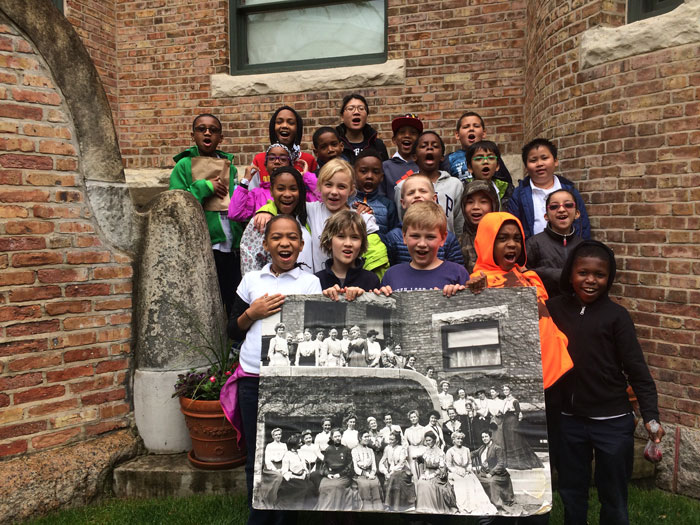-
Membership
Membership
Anyone with an interest in the history of the built environment is welcome to join the Society of Architectural Historians -
Conferences
Conferences
SAH Annual International Conferences bring members together for scholarly exchange and networking -
Publications
Publications
Through print and digital publications, SAH documents the history of the built environment and disseminates scholarship -
Programs
Programs
SAH promotes meaningful engagement with the history of the built environment through its programsMember Programs
-
Jobs & Opportunities
Jobs & Opportunities
SAH provides resources, fellowships, and grants to help further your career and professional life -
Support
Support
We invite you to support the educational mission of SAH by making a gift, becoming a member, or volunteering -
About
About
SAH promotes the study, interpretation, and conservation of the built environment worldwide for the benefit of all
Glessner House Museum Develops New Tour Program with SAH Grant
Jul 7, 2017
by
William Tyre, Executive Director and Curator, Glessner House Museum
The Glessner House Museum in Chicago was awarded a grant from the Society of Architectural Historians’ American Architecture and Landscape Field Trip Program to develop tours specifically geared toward underserved third grade students residing on the South Side of Chicago. The Museum hosted a total of 12 classes from late April through early June 2017 and the report of William Tyre, Glessner House Museum’s Executive Director and Curator, is below.

Photo by Michele Rudnick for Glessner House Museum
Tour Development
In the fall of 2016, a special committee comprised of two Glessner House Museum staff members and eight docents was formed to consider content for the tour and how it would relate to Illinois Learning Standards for the third grade. Two of the docents had previous experience working with students of this age, and were able to provide valuable input from the sites with which they were familiar. Other docents researched a variety of museums, including, but not limited to, house museums.
The committee felt it was important to establish a few main themes that would be reinforced throughout the tour. Ultimately, three themes were selected:
- What is a landmark and why are some houses turned into museums?
- How was life in the late 19th century different from today?
- Why does the building look the way it does and how did it function inside?
Docents and staff received special training, reinforcing the goal that they teach WITH the house, not ABOUT the house, so that the themes and ideas presented could connect to larger stories about Chicago and architecture in general. Docents were asked to become “the guide on the side” helping the group to explore and learn together.
Tour Structure
As the classes were to be broken up into smaller groups of ten students each, a series of ten identities were created and assigned to each child. These identities included members of the Glessner family, male and female guests, and several of the servants. Throughout the tour, students were asked how various rooms would have been used by them (i.e. their identity), whether they would have been permitted in the space at all, etc. In this way, the students were able to provide different perspectives about the overall arrangement of the rooms, what areas were designed specifically for family and servants, and how those areas were kept separate through the design of the building. A set of docent guidelines listed the types of questions asked in each of the four main stops on the tour. These were used as suggestions, with the docent building upon questions and comments from the students to explore the topics of specific interest to them. As was to be expected, every class was slightly different, and the docents enjoyed the variety of questions and were impressed by the students’ ability to compare and contrast life in the 1880s to today, as well as why the building looked so different from houses they know today.
Journal Project
At the conclusion of the tour, students returned to the coach house for a craft activity which involved the making of a journal. During the tour, the students learned that Mrs. Glessner kept a journal for over 40 years, and this was how we came to know so much about the Glessner family and their house. Using wallpaper books donated by a local company, students selected the colorful covers for their journal and then assembled it with a block of paper, and colorful fabric ties. Each student received a sheet of stickers with color photographs of various items they saw during the tour, and they also pasted in their “identity tag” to remind them of who they were during the tour.
Each student was asked to answer three questions in their journal:
- Who were you, and how does that person feel about the house?
- What was your favorite part of your trip through the house, and why?
- Would you like to live here? Why or why not?
Students also had the opportunity to fill out a 3 x 5 index card with comments about the tour which provided them the opportunity to give feedback.
At the conclusion of the craft project, students assembled on the curved porch in the courtyard for a class photo, recreating the famous photo of Mrs. Glessner’s Monday Morning Reading Class, which they learned about during the tour.
Summary
Participating docents and staff gathered for a debriefing session on June 6th. Overall, the comments from students and teachers were very positive, and all were most grateful for the opportunity to tour for free, as cost was clearly a limiting factor in planning fieldtrips for many of these schools. A graduate student intern will be working on refining the tour this summer, creating ancillary materials that can be distributed to teachers both in advance of, and following, their tours, as well as gathering hands-on items that can be used by students during tours.
William Tyre
Executive Director and Curator
Glessner House Museum


